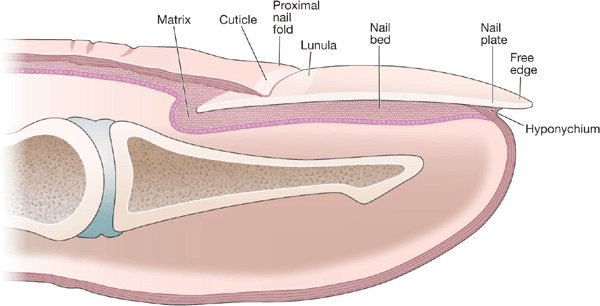The Hyponychium: The Nail Unit’s Secret Protector
In nail care, it’s easy to overlook the hyponychium, a small but essential part of our nail unit. This hidden gem protects our nails from harmful bacteria and pathogens, ensuring the overall health of our nails. So, let’s delve deeper into the fascinating world of the hyponychium and learn how to take care of this unsung hero.
What exactly is Hyponychium?
The hyponychium is a protective seal beneath the nail plate’s free edge at the tip of our fingers. Its primary function is to form a tight barrier that prevents bacteria and pathogens from entering the sensitive areas of the nail unit. The hyponychium is an early warning system with numerous nerve endings if its protective seal is compromised.

What it’s made of
Comprising a thick layer of keratinized cells, the hyponychium is a sturdy structure that endures daily wear and tear. Its keratin-rich composition imparts strength and flexibility, effectively protecting the nail bed.
Why is it so important?
The hyponychium’s role in maintaining our nail health is crucial. Creating a barrier against foreign substances like dirt and bacteria helps protect our nails from infections and other potential issues. Without it, our nails would be significantly more susceptible to problems.
Looking After Your Hyponychium
Please don’t push it back.
A common myth is that you should push it back like the cuticle. This is far from the truth. The hyponychium plays a vital role in the nail unit’s defenses and should be undisturbed.
Keep it moisturized with nail oil.
Maintaining a healthy hyponychium is essential to keep it well-moisturized using high-quality nail oil. Doing so will prevent dryness and ensure it remains supple and robust.
Be Gentle
Regarding your Eponychium, a little TLC goes a long way. Avoid harsh chemicals, excessive buffing, or aggressive manicure techniques. Instead, treat your nails with the respect they deserve, and they’ll thank you in the long run.
The Hyponychium and Other Nail Components
Hyponychium vs. eponychium
The hyponychium acts as the seal at the fingertip, whereas the eponychium is an area beneath the proximal nail fold responsible for shedding dead skin cells. Although they play different roles, both components are essential for maintaining the nail unit’s integrity.
Hyponychium vs. cuticle
The cuticle is a thin layer of dead skin cells that adhere to the nail plate, providing additional protection. Although the hyponychium and cuticle are protective barriers, they are located at distinct parts of the nail unit.
Common Concerns Related to the Hyponychium
Inverse Pterygium: Overgrowth
Inverse Pterygium occurs when the Hyponychium grows over the nail plate, often accompanied by blood and nerve endings. In such cases, it’s crucial to leave it undisturbed. In addition, regular applications of nail oil can help maintain its suppleness.
Infections
Infections can develop if the Hyponychium’s protective seal is compromised. If you experience pain, redness, or swelling, consult a healthcare professional for appropriate treatment.
Tips and Tricks for Optimal Nail Health
Now that we’ve explored the importance of Hyponychium and how to care for it, let’s discuss some tips and tricks to ensure optimal nail health.
Trim Your Nails Regularly
Keeping your nails trimmed helps maintain their appearance and reduces the risk of accidental damage to the Hyponychium. Use clean, sharp nail clippers or scissors to trim your nails straight across, then round the tips in a gentle curve.
Wear Gloves When Cleaning
Always wear gloves when cleaning products or washing dishes to protect them and the rest of your nail unit from harsh chemicals. These chemicals can strip the natural oils from your nails, causing dryness and damage.
Avoid Nail Biting
Nail biting can damage the hyponychium and make it more susceptible to infections. If you struggle with this habit, try using bitter-tasting nail polish or engage in stress-reducing activities to help curb the urge to bite.
Choose Your Nail Products Wisely
When selecting nail products, choose those free from harsh chemicals like formaldehyde and toluene. These substances can weaken the hyponychium and cause dryness. Instead, choose nail products that contain nourishing ingredients like vitamins and natural oils.
Don’t Forget Your Toenails
Although we often focus on our fingernails, it’s essential not to neglect our toenails. It is also present in our toenails and serves the same protective function. Maintaining proper foot hygiene, trim your toenails regularly, and moisturize the hyponychium to ensure overall nail health.
FAQs
How should I treat overgrowth?
Hyponychium overgrowth, or inverse pterygium, should be left alone. Keep it supple by applying nail oil regularly.
How can I tell if mine is healthy?
A healthy Eponychium should be smooth, supple, and free of cracks or inflammation. It should also adhere closely to the nail plate, forming a tight seal.
What causes the hyponychium to detach?
Detachment can happen due to trauma, fungal infections, or specific medical conditions. If you suspect detachment, seek medical advice promptly.
Can I push it back?
No, unlike the cuticle, it should not be pushed back. Doing so can harm the nail and cause infections.
Why is my hyponychium red and swollen?
Redness and swelling may indicate inflammation or infection. Consult a healthcare professional for an accurate diagnosis and treatment.
How can I strengthen it?
Proper nail hygiene, using nourishing cuticle oils, and avoiding activities that can damage it, such as nail-biting, can help strengthen it.
Will it grow back if damaged?
In most cases, the hyponychium can regenerate if damaged. However, the healing process may take time, and you must consult a healthcare professional if you’re concerned about your hyponychium’s health.
In summary, the hyponychium may be a small, often overlooked component of the nail unit, but its contribution to maintaining healthy nails is significant. By understanding its role, avoiding common misconceptions, and incorporating proper nail care techniques, you can support the health and integrity of your nails. So, the next time you’re giving your nails some attention, remember to appreciate hyponychium’s vital role in keeping your nails healthy and strong!


